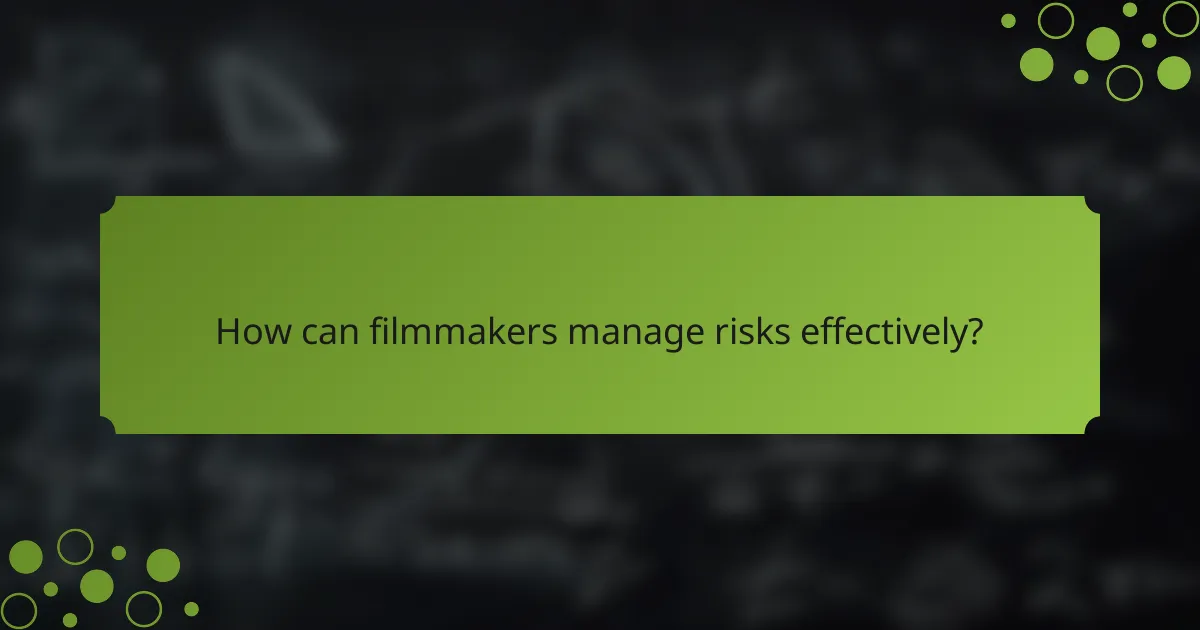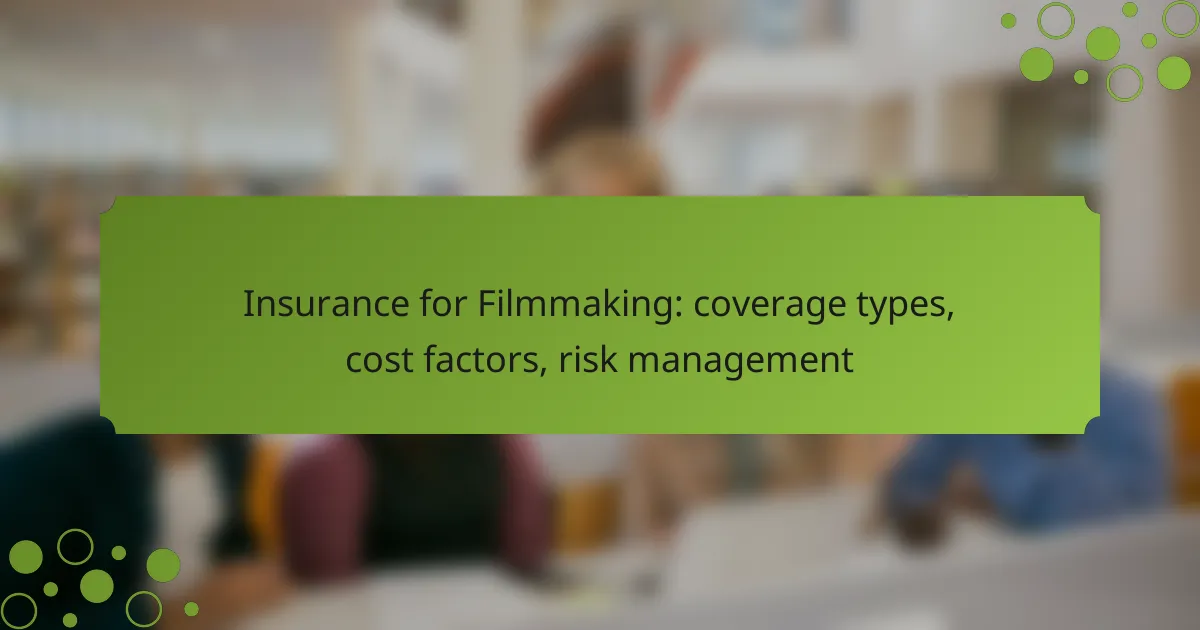Filmmaking in Australia involves navigating various risks, making insurance an essential component of the production process. Key coverage types include production, equipment, liability, errors and omissions, and workers’ compensation insurance. The cost of this insurance can vary significantly based on factors such as coverage type, project scale, and location, highlighting the importance of effective budgeting and risk management for filmmakers.

What types of insurance are essential for filmmaking in Australia?
Filmmaking in Australia requires several types of insurance to protect against various risks. Essential coverage includes production, equipment, liability, errors and omissions, and workers’ compensation insurance.
Production insurance
Production insurance is crucial for covering the overall film project against unforeseen events that could cause financial loss. This type of insurance typically includes coverage for cancellation, delays, and accidents that may occur during filming.
When considering production insurance, filmmakers should evaluate the specific risks associated with their project, such as location, cast, and crew size. Policies can vary significantly in cost, often ranging from a few thousand to tens of thousands of Australian dollars, depending on the scale of the production.
Equipment insurance
Equipment insurance protects filmmakers from loss or damage to their filming gear, including cameras, lighting, and sound equipment. This coverage is essential, as equipment can be expensive and vulnerable to theft or accidents.
Filmmakers should assess the value of their equipment and consider whether to insure individual items or opt for a blanket policy. Premiums can vary based on the total value insured, typically ranging from 1-3% of the equipment’s value annually.
Liability insurance
Liability insurance safeguards filmmakers against claims of bodily injury or property damage that may occur during production. This coverage is vital for protecting both the production team and third parties involved in the filming process.
In Australia, filmmakers often require public liability insurance, which can cover claims up to several million dollars. Costs can vary widely based on the coverage limits and the nature of the project, generally starting from a few hundred dollars for smaller productions.
Errors and omissions insurance
Errors and omissions (E&O) insurance protects filmmakers from legal claims related to copyright infringement, defamation, or invasion of privacy. This coverage is particularly important for projects that involve sensitive content or third-party materials.
Filmmakers should consider obtaining E&O insurance before distributing their work, as many distributors and festivals require it. Costs can range from a few thousand to tens of thousands of Australian dollars, depending on the project’s complexity and exposure.
Workers’ compensation insurance
Workers’ compensation insurance is mandatory for filmmakers in Australia to cover medical expenses and lost wages for crew members injured on set. This insurance ensures that workers receive appropriate care without financial burden on the production.
Filmmakers should familiarize themselves with local regulations regarding workers’ compensation, as requirements can vary by state. Premiums are typically calculated based on the total payroll and the associated risk levels, often amounting to a few percent of the total wages paid.

How much does filmmaking insurance cost in Australia?
The cost of filmmaking insurance in Australia typically ranges from a few hundred to several thousand Australian dollars, depending on various factors such as coverage type, project scale, and location. Understanding these elements can help filmmakers budget effectively for their insurance needs.
Average cost factors
Several factors influence the average cost of filmmaking insurance, including the type of coverage selected, the duration of the project, and the specific risks associated with the production. For instance, general liability insurance may be less expensive than production insurance, which covers equipment and crew. Filmmakers should expect to pay higher premiums for more comprehensive coverage that addresses a wider range of risks.
Additionally, the experience level of the production team can impact costs. Insurers may offer lower rates to established filmmakers with a proven track record, while new entrants may face higher premiums due to perceived risks.
Premium variations by coverage type
Filmmaking insurance encompasses various coverage types, each with distinct premium costs. General liability insurance, which protects against third-party claims, is generally more affordable, often starting in the low hundreds of AUD. In contrast, production insurance, which covers equipment and crew injuries, can range from a few hundred to several thousand AUD, depending on the project’s complexity.
Other specialized coverages, such as errors and omissions insurance, may also add to the overall cost. Filmmakers should evaluate their specific needs to determine which coverage types are essential for their project.
Impact of project scale on pricing
The scale of a filmmaking project significantly affects insurance pricing. Smaller projects, such as short films or independent productions, typically incur lower insurance costs, often in the hundreds of AUD. Larger productions, like feature films or commercials, may require extensive coverage, leading to premiums in the thousands of AUD.
As projects scale up, the potential risks increase, prompting insurers to adjust premiums accordingly. Filmmakers should assess their project’s scale and associated risks to ensure they secure adequate coverage without overspending.
Location-based pricing differences
Filming location can also influence insurance costs in Australia. Productions based in major cities, such as Sydney or Melbourne, may face higher premiums due to increased risk factors like urban hazards and higher costs of living. Conversely, projects in rural areas might benefit from lower rates, although they may encounter challenges related to fewer available resources and services.
Filmmakers should research local insurance providers and compare quotes to find the best coverage options for their specific filming locations. Understanding regional pricing differences can lead to more informed budgeting decisions.

What are the risks associated with filmmaking?
Filmmaking involves various risks that can impact production, finances, and safety. Understanding these risks is crucial for effective risk management and ensuring a successful project.
Equipment theft
Equipment theft is a significant risk in filmmaking, as valuable gear can be targeted during shoots or while in transit. Filmmakers should consider investing in comprehensive insurance that covers theft, which can help mitigate financial losses.
To reduce the risk of theft, implement security measures such as hiring security personnel, using tracking devices, and securing equipment in locked vehicles or storage. Keeping an inventory of all equipment can also aid in recovery efforts if theft occurs.
Injury on set
Injury on set poses a serious risk to cast and crew, potentially leading to costly medical expenses and production delays. Ensuring a safe working environment is essential, and filmmakers should prioritize safety protocols and training for all personnel.
Consider obtaining liability insurance that covers injuries on set. Additionally, conducting regular safety meetings and having first aid kits readily available can help manage this risk effectively.
Production delays
Production delays can arise from various factors, including weather conditions, equipment failure, or scheduling conflicts. These delays can lead to increased costs and may affect the overall timeline of the project.
To minimize production delays, create a detailed shooting schedule with built-in buffer time for unforeseen issues. Having contingency plans and flexible contracts can also help manage the impact of delays on the budget and timeline.
Legal disputes
Legal disputes in filmmaking can stem from copyright issues, contract disagreements, or liability claims. These disputes can be costly and time-consuming, making it vital to have legal protections in place.
Filmmakers should consider obtaining legal insurance and consulting with legal professionals to draft clear contracts. Understanding copyright laws and ensuring all necessary permissions are secured can also help prevent legal issues from arising.

How can filmmakers manage risks effectively?
Filmmakers can manage risks effectively by implementing structured safety protocols, conducting thorough risk assessments, and utilizing experienced crew members. These strategies help minimize potential hazards and ensure a smoother production process.
Implementing safety protocols
Establishing clear safety protocols is essential for reducing risks on set. This includes creating guidelines for equipment handling, emergency procedures, and health protocols, especially in light of health regulations that may vary by location.
For example, a production might require all crew members to wear personal protective equipment (PPE) in specific environments or during particular activities. Regular safety meetings can reinforce these protocols and ensure everyone is aware of their responsibilities.
Conducting risk assessments
Conducting risk assessments involves identifying potential hazards associated with the filming process and evaluating their likelihood and impact. This proactive approach allows filmmakers to address issues before they escalate.
Filmmakers should consider factors such as location safety, equipment risks, and weather conditions. Documenting these assessments and regularly updating them throughout the production can help maintain a safe environment.
Utilizing experienced crew
Hiring experienced crew members can significantly reduce risks on set. Skilled professionals are more likely to recognize potential hazards and implement effective solutions quickly. Their familiarity with industry standards and safety practices can enhance overall production safety.
When assembling a team, prioritize individuals with a proven track record in their respective roles. This not only improves safety but also boosts the efficiency and quality of the production process.

What criteria should filmmakers consider when choosing insurance?
Filmmakers should consider coverage types, limits, and costs when selecting insurance. Understanding the specific risks associated with their projects and the necessary protections can guide them in making informed decisions.
Coverage limits
Coverage limits refer to the maximum amount an insurance policy will pay for a covered loss. Filmmakers must assess the potential risks involved in their productions, such as equipment damage, liability claims, or production delays, to determine appropriate coverage limits.
For example, a small independent film may require coverage limits in the low hundreds of thousands of dollars, while larger productions could need millions in coverage. It’s essential to evaluate the scale of the project and the value of the assets involved to set adequate limits.
Filmmakers should also be aware of the difference between per-occurrence limits and aggregate limits. Per-occurrence limits cap the payout for each individual claim, while aggregate limits cap the total payouts within a policy period. Understanding these distinctions can help filmmakers choose the right policy for their needs.
